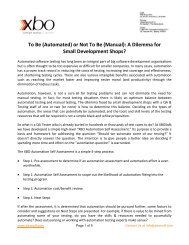Download - Bitpipe
Download - Bitpipe
Download - Bitpipe
Create successful ePaper yourself
Turn your PDF publications into a flip-book with our unique Google optimized e-Paper software.
SEARCHSECURITY. COMtechnicalguide onEMERGINGthreatsthreatscontentshreats3 Understanding Modern Attackand Defense Techniques10 Sponsor resources
Did youknow79%of Web sites with maliciouscode are legitimate sitesthat have been compromisedThink you know where the biggestthreats exist on the Web?Check your assumptions by reviewing our latest Threat Report.It looks back at last year and makes predictions for 2011 and it'scrammed with intelligence that may surprise you.Websense 2010 Threat Reportwebsense.com/threatreport2010
| EMERGING THREATSCYBERCRIMEUnderstanding Modern Attackand Defense TechniquesAttackers have ramped up their efforts with a dangerouscocktail of social engineering, Web-based attacks andpersistence. How will your organization stay ahead?BY LENNY ZELTSERTAKES TIME and money to adjust IT security in response to evolving attack tactics.As defenders gradually update their security measures, attackers respond accordingly.Such arms-race dynamics lead to threats of increasing sophistication and efficiency.UNDERSTANDINGToday’s cybercriminals often have a long-term interest in their targets, and oftenMODERN ATTACK ANDemploy social engineering to get inside a protected environment. Their tactics commonlyinclude malicious payload that attempts to compromise the victim’s systemDEFENSE TECHNIQUESand may continue spreading within the organization. They also increasingly focuson weaknesses at the application, rather than at system or network levels, to obtaindata that provide the most value.SPONSOR RESOURCESiITDefending IT infrastructure involves understanding attack tactics that are particularlyeffective today. As you assess and improve your information security program,consider the following characteristics of modern computer security threats and therecommendations for dealing with them.HOW SOCIAL ENGINEERING BYPASSES TECHNICAL DEFENSESAttackers increasingly employ social engineering tactics to exploit natural human predispositionswith the goal of bypassing defenses. Such approaches can persuade victimsinto clicking on malicious links, open exploit-laden attachments and install malicioussoftware. The psychological factors attackers incorporate into social engineering attacksinclude the following:• People pay attention to personally relevant messaging. For instance, a variant ofthe Waledac worm directed its potential victims to a website that showed a news excerptabout a supposed explosion. The message was customized to include the geographiclocation of the visitor as the place where the supposed explosion occurred to enticethe person to install a (Trojan) video player for viewing the personally relevant new3SEARCHSECURITY.COMTechnical Guide on Emerging Threats
| EMERGING THREATSUNDERSTANDINGMODERN ATTACK ANDDEFENSE TECHNIQUESSPONSOR RESOURCESstory. In another example, attackers sent targeted email messages with maliciousattachments under the guise of providing an agenda for an upcoming meeting. Theattacker bet on the likelihood that the recipient had a meeting coming up and wouldwant to view the agenda.• People comply with social norms, looking at others for behavioral cues. One exampleof this behavior is the people’s tendency to click on links shared by their friends onsocial networking sites such as Facebook andTwitter. The Koobface worm has been highlysuccessful at convincing people to visit maliciouswebsites by posting its links using thevictims’ social networking accounts. In anotherexample, the Nugache worm used infectedsystems to download its malicious componentsfrom a legitimate download-tracking site,boosting the popularity of its files to attractnew victims.• People place trust in security tools. Muchlike people put trust into the individuals wholook like doctors by wearing lab coats, usersSuch social engineeringtechniques merge the linebetween external andinternal threats becausesocial engineering willallow external attackersto quickly gain an internalvantage point.sometimes blindly trust the measures taken for the sake of security. Rogue antivirustools have been highly successful at spreading by convincing victims that their computersare infected and demand immediate intervention. Attackers have also used digitalcertificates to sign malicious executables—as was the case with Stuxnet—with theexpectation that seeing a signed file would lower the target’s guard.Such social engineering techniques merge the line between external and internalthreats, because social engineering will allow external attackers to quickly gain aninternal vantage point. Once inside the protected perimeter, for instance, attackers tendto pursue targets that are inaccessible from the outside. To account for this threat vector,incorporate social engineering concepts into your security awareness program to makeyour employees more resistant to such tactics. Assess the extent to which your employeeslearned key concepts, provide feedback and adjust training, if necessary.Employ security defenses assuming that some employees will be social engineereddespite the security awareness training. This involves:• Locking down the workstation to minimize the damage a process running withuser’s privileges can cause• Limiting the rights employees have to access the network and applications to matchtheir business needs• Reviewing activity logs to identify when user accounts and access is being misused.• Evaluating the effectiveness of your browser security software in its ability torestrict access to dangerous content or code downloaded by the user.4SEARCHSECURITY.COMTechnical Guide on Emerging Threats
| EMERGING THREATSTARGETING WORKSTATIONS THROUGH THE BROWSERAttackers have been successful at penetrating enterprise defenses by taking advantageof bugs in the Web browser or in software that the Web browser can invoke. Suchclient-side exploits have targeted browser add-ons such as Flash and Java RuntimeEnvironment (JRE), as well as the code that is part of the Web browser itself. Theyhave also targeted document viewers and editors, such as Adobe Reader and MicrosoftOffice. The exploits might be delivered to victims via email, in the form of attachmentsor links, or might be presented when the victim encounters a malicious website whilebrowsing the Web.Although client-side exploits have been part of the threat landscape for a number ofyears, several factors are making workstations a more attractive target than ever before:• Defenders seem to be getting better at locking down server infrastructure.• The shift in corporate culture and the availability of externally hosted applicationsare making it more common for employees to work outside of the protectednetwork perimeter.• Individuals who embraced online social networking seem to have gotten morepromiscuous about sharing and clicking on links.UNDERSTANDINGMODERN ATTACK ANDDEFENSE TECHNIQUESSPONSOR RESOURCESA key characteristic of anexploit kit is the ease withwhich it can be used evenby attackers who are notIT or security experts.Another factor that seems to be makingattacks on workstations more frequent is theincreased availability and of powerful exploitkits, which automate the exploitation of clientsidevulnerabilities. A key characteristic of anexploit kit is the ease with which it can be usedeven by attackers who are not IT or securityexperts. An exploit kit acts as a launching platformto deliver other payload, which may include a bot, a backdoor, spyware or anothertype of malware.Attackers will continue to pursue vulnerabilities in workstations that could beexploited through victims’ web browsers. Consider the following measures toimprove your ability to withstand such tactics:• Use enterprise management system (EMS) tools, such as Group Policy, to centrallymanage Web browser settings, disabling unnecessary features, configuring proxies, turningoff risky add-ons, and so on.• Follow the development of new browser features, such as sandboxes incorporatedinto Internet Explorer and Google Chrome. Consider such evolving security capabilitieswhen deciding which web browsers to mandate or recommend for your users.• Review the use of secure compilation practices, such as ASLR and DEP, in softwarethat might be targeted through the browser. For instance, a zero-day exploit discoveredin December 2010 targeted an Internet Explorer DLL that wasn’t compiled to supportASLR, allowing the attacker to compromise affected workstations. Microsoft’s Process5SEARCHSECURITY.COMTechnical Guide on Emerging Threats
| EMERGING THREATSExplorer and Enhanced Mitigation Experience Toolkit (EMET) tools can assist with thisprocess.• Limit the local privileges that users have on their workstations, making it harder formalware to reach its full potential on the host. This often involves removing administrativerights from users who don’t need them, or stripping the more sensitive privileges fromadministrative groups. User Account Control (UAC) capabilities of Windows Vista and 7offer similar advantages even to users logged in with local administrative rights.• Assess capabilities of the security tools you use to protect web browsing activities atnetwork and endpoint levels. Consider deploying products that have features specificallydesigned for identifying malicious activities in web traffic and protecting the browser.UNDERSTANDINGMODERN ATTACK ANDDEFENSE TECHNIQUESSPONSOR RESOURCESCOMPROMISING WEB APPLICATIONSAs our infrastructure security practices mature, attackers are turning their attention toWeb applications. In some cases, the attackers’ goal is to compromise websites so thatthey can be used to target client-side vulnerabilities through visitors’ browsers. Attackersalso commonly pursue Web applications that process or store valuable data. Such application-levelattacks, which have been very successful at bypassing defenses, include thefollowing tactics:• SQL injection attacks, which bypass the application’s input filters to gainunrestrained access to the underlying database• Business logic flaws, which exploit the weaknesses in workflows implemented bythe application, such as a way to identify all valid usernames by using the passwordreset page.• Password brute-forcing methods, which use automated tools to guess passwordsthat use known dictionary words or that are otherwise predictable• Cross-site scripting (XSS) attacks, which bypass the application’s input or outputfilters to execute malicious scripts in the browser of the application’s userThe list of effective application-level attack vectors is too long to be included here.For more details, take a look at the OWASP Top Ten Project. Why are so many applicationsvulnerable to such tactics? Partly, it’s because many developers aren’t trainedto write attack-resistant code. Moreover, developers’ incentives prioritize features anddeadlines over the application’s defensive posture. Yet another reason is the infrastructurefocus of many security programs, which don’t provide the necessary focus on applicationlevelissues.Here are a few suggestions for tackling the challenges of application-level threats andvulnerabilities:• Break down the wall between infrastructure and application security teams in yourorganization, encouraging collaboration and making sure the company pays dueattention to application-level security issues.• Understand the business purpose of the applications, combining that knowledge6SEARCHSECURITY.COMTechnical Guide on Emerging Threats
| EMERGING THREATSwith the details regarding how sensitive data flows through the applications and theinfrastructure. Use this information to prioritize your security efforts.• Include application components in your penetration testing projects to mimic thelikely actions of attackers seeking to bypass your defenses. Be sure to incorporate manualtesting, since fully automated techniques are likely to produce numerous false positivesand false negatives.• Include application logs as part of your log management or security information andevent management (SIEM) efforts. Incorporate security alerting and logging specs intoyour application development requirements to support this.• Incorporate application-related steps into your incident response plan. Too often,organizations focus on only system or network-level actions when preparing to dealwith security incidents.• Establish a practical and comprehensive Web application security program, whichshould include security coding and application architecture guidelines, developer trainingfor secure coding practices and automated ways of identifying at least some vulnerabilitiesduring code creation, testing and deployment.UNDERSTANDINGMODERN ATTACK ANDDEFENSE TECHNIQUESSPONSOR RESOURCESATTACKERS WITH LONG-TERM INTERESTSWhile a fair number of intrusions can still be classified as quick hit-and-run incidentsmany attackers have demonstrated the desire and ability to invest into long-termcampaigns for achieving financial and, in some cases, political objectives. Such focusedactivities are typically comprised of a series of events that are spread over a period ofmonths and even years. Recently, attacks with long-term interests took on the forms:• Attackers deploy malware that acts as a crimeware platform diverse activities,including data exfiltration, distributed denial-of-service (DDoS) attacks and spamcampaigns. For instance, the Conficker worm spread quickly without a “business”purpose that was initially observable; the for malware was later used for variousmoney-making schemes.• Attackers research the people and technologies that comprise targeted organizations.This helps ensure the success of the initial compromise and follow-up actions. Clientsideattacks might be directed at specific individuals to target the software installed ontheir workstations in the context that wouldn’t arouse suspicions. Another illustrationof the preparation exhibited by attackers was evident in the Stuxnet incident.• Attackers adjust tactics in response to defenders actions. For instance, the groupbehind the Koobface worm modified the manner in which its malware uses socialnetworks to adjust for those sites’ security improvements. Similar characteristicswere exhibited by attackers in identified advanced persistent threat (APT) incidents.• Attackers maintain persistent presence in the compromised environment. As a result,even if the organization discovers some of the compromised systems, the attacker is ableto continue operating within the organization’s infrastructure. These characteristicshave been described in the context of APT scenarios.7SEARCHSECURITY.COMTechnical Guide on Emerging Threats
| EMERGING THREATSConsider the following recommendations to prepare for dealing with incidents thatmight be attributed to attackers with long-term incidents:• Change the perspective of your security efforts from attempting to preventbreaches—which unrealistic in the face of most targeted attacks—to resisting intrusions.The change involves accepting that a compromise will occur and considering how youwill detect and respond to it.• Understand where your valuable data is located and adjust your defensive spendingaccordingly, making it more expensive for attackers to achieve their likely objectives.• Identify the individuals who are most likely to be targeted, perhaps because theyare in the public eye or because they have access to valuable data. Provide them withadditional security training and security mechanisms to better resists attacks directedat them.• Educate employees about risks of data leaked inadvertently on public forums, suchas social networks and blogs. Explain how attackers who profile activities over time cangather meaning and actionable intelligence from the bits of data that might be innocuousby themselves.UNDERSTANDINGMODERN ATTACK ANDDEFENSE TECHNIQUESSPONSOR RESOURCESModern computer attacks understand the weaknesses inherent in their targets’defensive capabilities sometimes better than the targeted organizations themselves.Intruders often incorporate elements of social engineering to persuade victims to takeactions desired by the attackers, such as clickingon links, spreading URLs or supplying logoncredentials. Attackers frequently target clientsidevulnerabilities, recognizing that enterpriseshave a hard time keeping workstations up todate on security patches.Cybercriminals also target vulnerabilitiesin web applications to obtain access to valuabledata and to gain a platform for attacking websitevisitors. Many attackers are part of wellorganizedprofit-motivated groups, who areModern computer attacksunderstand the weaknessesinherent in their targets’defensive capabilitiessometimes better thanthe targeted organizationsthemselves.willing to invest time and money towards achieving their objectives. As the result,organizations need to be prepared to handle attack campaigns that might spanmonths and years. Resisting the attack tactics discussed above involves understandingthe threats, so you can build and adjust your defenses accordingly.wLenny Zeltser leads the security consulting team at Savvis and teaches classes on combating and analyzingmalware at SANS Institute. He regularly discusses information security topics on his blog and on Twitter.8SEARCHSECURITY.COMTechnical Guide on Emerging Threats
| EMERGING THREATSTECHTARGET SECURITY MEDIA GROUPVICE PRESIDENT/GROUP PUBLISHERDoug OlenderEDITORIAL DIRECTOR Michael S. MimosoSEARCHSECURITY.COMSENIOR SITE EDITOR Eric ParizoSITE EDITOR Marcia SavageUK BUREAU CHIEF Ron CondonNEWS DIRECTOR Robert WesterveltSITE EDITOR Jane WrightASSISTANT EDITOR Maggie SullivanASSOCIATE EDITOR Carolyn GibneyASSISTANT EDITOR Greg SmithART & DESIGNCREATIVE DIRECTOR Maureen JoycePUBLISHER Josh GarlandDIRECTOR OF PRODUCT MANAGEMENTSusan ShaverDIRECTOR OF MARKETING Nick DowdSALES DIRECTOR Tom ClickCIRCULATION MANAGER Kate SullivanPROJECT MANAGER Elizabeth LareauPRODUCT MANAGEMENT & MARKETINGCorey Strader, Andrew McHugh,Karina RousseauSALES REPRESENTATIVESEric Belcher ebelcher@techtarget.comPatrick Eichmannpeichmann@techtarget.comLeah Paikin lpaikin@techtarget.comUNDERSTANDINGMODERN ATTACK ANDDEFENSE TECHNIQUESJeff Tonello jtonello@techtarget.comNikki Wise nwise@techtarget.comTECHTARGET INC.CHIEF EXECUTIVE OFFICER Greg StrakoschPRESIDENT Don HawkSPONSOR RESOURCESEXECUTIVE VICE PRESIDENT Kevin BeamCHIEF FINANCIAL OFFICER Jeff WakelyEUROPEAN DISTRIBUTIONParkway Gordon Phone 44-1491-875-386www.parkway.co.ukLIST RENTAL SERVICESJulie BrownPhone 781-657-1336 Fax 781-657-1100“Technical Guide on Emerging Threats” is published by TechTarget, 275 Grove Street,Newton, MA 02466 U.S.A.; Toll-Free 888-274-4111; Phone 617-431-9200; Fax 617-431-9201.All rights reserved. Entire contents, Copyright © 2011 TechTarget. No part of this publicationmay be transmitted or reproduced in any form, or by any means without permissionin writing from the publisher, TechTarget or SearchCloudSecurity.com.9SEARCHSECURITY.COMTechnical Guide on Emerging Threats
Did youknow22.4%of searches for trendingnews (buzz words)lead to malwareThink you know where the biggestthreats exist on the Web?Check your assumptions by reviewing our latest Threat Report.It looks back at last year and makes predictions for 2011 andit's crammed with intelligence that may surprise you.Websense 2010 Threat Reportwebsense.com/threatreport2010
RESOURCES FROM OUR SPONSOR• Websense Advanced Classification Engine video• 2010 Threat Report and next 12 monthsAbout Websense:Websense is the global leader in integrated Web, data and email security. Websense softwareand hosted security solutions protect more than 42 million employees worldwide, and helpmore than 50,000 organizations say Yes to Web 2.0.













